San Diego Padres

San Diego Padres

| San Diego Padres | |||||
|---|---|---|---|---|---|
| Established in 1969 | |||||
| |||||
| Major league affiliations | |||||
| |||||
| Current uniform | |||||
| Retired numbers |
| ||||
| Colors | |||||
| Name | |||||
| |||||
| Other nicknames | |||||
| |||||
| Ballpark | |||||
| |||||
| Major league titles | |||||
| World Series titles(0) | None | ||||
| NL Pennants(2) |
| ||||
| West Division titles(5) |
| ||||
| Wild card berths(0) | None | ||||
| Front office | |||||
| Owner(s) | Ron Fowler[4] | ||||
| Manager | Rod Barajas | ||||
| General Manager | A. J. Preller | ||||
| President of Baseball Operations | A. J. Preller | ||||
The San Diego Padres are an American professional baseball team based in San Diego, California. The Padres compete in Major League Baseball (MLB) as a member club of the National League (NL) West division. Founded in 1969, the Padres have won two NL pennants — in 1984 and 1998, losing in the World Series both years. As of 2018, they have had 14 winning seasons in franchise history.[5] The Padres are one of two Major League Baseball teams (the other being the Los Angeles Angels) in California to originate from that state; the Athletics were originally from Philadelphia (and moved to the state from Kansas City), and the Dodgers and Giants are originally from two New York City boroughs – Brooklyn and Manhattan, respectively. The Padres are the only MLB team that does not share its city with another franchise in the four major American professional sports leagues. The Padres are the only major professional sports franchise to be located in San Diego, following the relocation of the Chargers to Los Angeles in 2017. They are also the only franchise in the MLB not to have a no-hitter, having gone 8020 games without throwing one, a major league record to begin a franchise.[6]
| San Diego Padres | |||||
|---|---|---|---|---|---|
| Established in 1969 | |||||
| |||||
| Major league affiliations | |||||
| |||||
| Current uniform | |||||
| Retired numbers |
| ||||
| Colors | |||||
| Name | |||||
| |||||
| Other nicknames | |||||
| |||||
| Ballpark | |||||
| |||||
| Major league titles | |||||
| World Series titles(0) | None | ||||
| NL Pennants(2) |
| ||||
| West Division titles(5) |
| ||||
| Wild card berths(0) | None | ||||
| Front office | |||||
| Owner(s) | Ron Fowler[4] | ||||
| Manager | Rod Barajas | ||||
| General Manager | A. J. Preller | ||||
| President of Baseball Operations | A. J. Preller | ||||
Franchise history
Minor league team
The Padres adopted their name from the Pacific Coast League team that arrived in San Diego in 1936. That minor league franchise won the PCL title in 1937, led by 18-year-old Ted Williams, the future Hall-of-Famer who was a native of San Diego. The team's name, Spanish for "fathers", refers to the Spanish Franciscan friars who founded San Diego in 1769.
Major league team
In 1969, the Padres joined the ranks of Major League Baseball as one of four new expansion teams, along with the Montreal Expos (now the Washington Nationals), the Kansas City Royals, and the Seattle Pilots (now the Milwaukee Brewers). Their original owner was C. Arnholt Smith, a prominent San Diego businessman and former owner of the PCL Padres whose interests included banking, tuna fishing, hotels, real estate and an airline. Despite initial excitement, the guidance of longtime baseball executives, Eddie Leishman and Buzzie Bavasi as well as a new playing field, the team struggled; the Padres finished in last place in each of its first six seasons in the NL West, losing 100 games or more four times. One of the few bright spots on the team during the early years was first baseman and slugger Nate Colbert, an expansion draftee from the Houston Astros and still the Padres' career leader in home runs.
The team's fortunes gradually improved as they won five National League West titles and reached the World Series twice, in 1984 and in 1998, but lost both times. The Padres' main draw during the 1980s and 1990s was Tony Gwynn, who won eight league batting titles. They moved into their current stadium, Petco Park, in 2004.
As of 2019, the Padres are the only team in MLB yet to throw a no-hitter. On September 5, 1997, Andy Ashby took a no-hitter into the 9th inning, which is as close as the team has come to achieving this feat.
Spring training

Padres primary logo, 2012–15
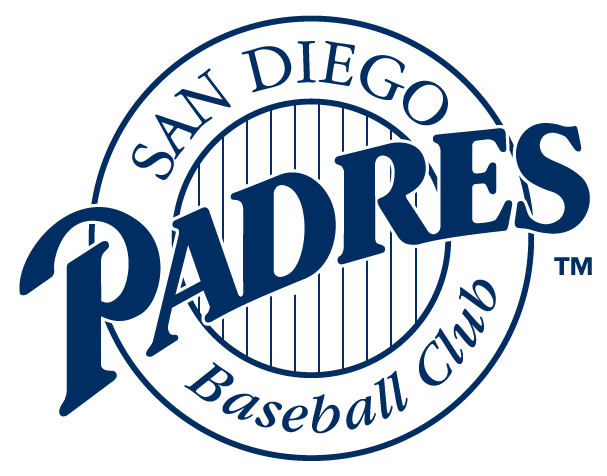
Padres alternate logo, 2000–03

Padres logo, 1991–2003
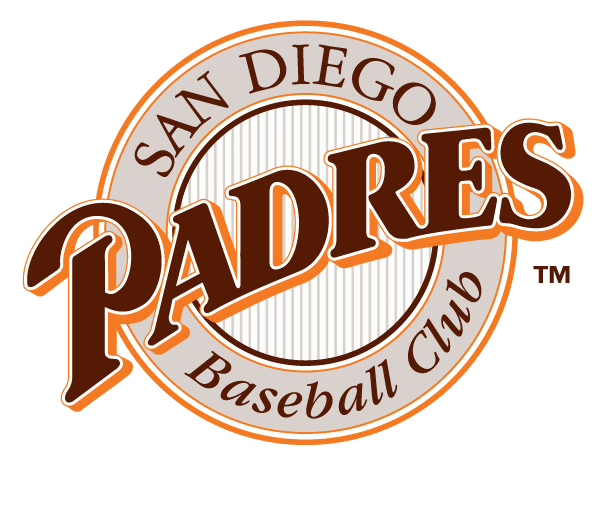
Padres logo, 1990
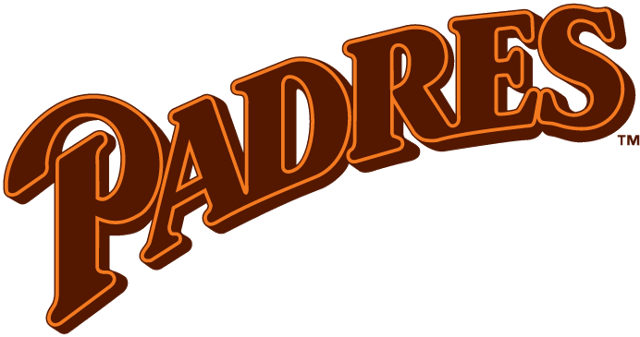
Padres logo, 1986–89
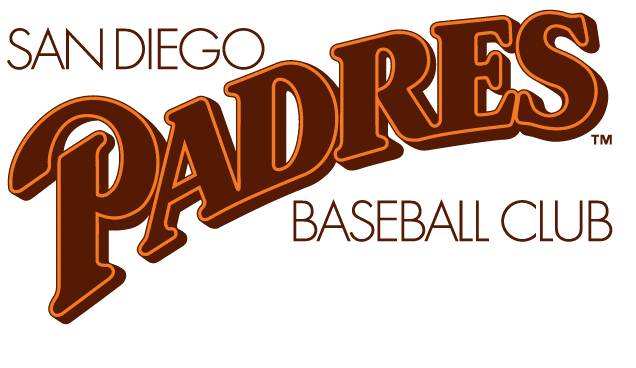
Padres logo, 1985
The team has played its spring training games at the Peoria Sports Complex in Peoria, Arizona since 1994. They share the stadium with the Seattle Mariners.
From 1969 to 1993, the Padres held spring training in Yuma, Arizona at Desert Sun Stadium. Due to the short driving distance and direct highway route (170 miles, all on Interstate 8), Yuma was very popular with Padres fans, and many fans would travel by car from San Diego for spring training games. The move from Yuma to Peoria was very controversial, but was defended by the team as a reflection on the low quality of facilities in Yuma and the long travel necessary to play against other Arizona-based spring training teams (whose sites were all in the Phoenix and Tucson areas, both rather far from Yuma).
Logos and colors
Throughout the team's history, the San Diego Padres have used multiple logos, patches, and color combinations. One of their first patches depicts a friar swinging a bat with Padres written at the top while standing in a sun-like figure with San Diego Padres on the exterior of it. The "Swinging Friar" has popped up on the uniform on and off ever since (he is currently on the left sleeve of the navy alternate jersey) although the head of the friar has been tweaked from the original in recent years, and it is currently the mascot of the team.
In 1985, the Padres switched to using a script-like logo in which Padres was written sloped up. That would later become a script logo for the Padres. The team's colors were changed to brown and orange and remained this way through the 1990 season.
In 1989, the Padres took the scripted Padres logo that was used from 1985 to 1988 and put it in a tan ring that read "San Diego Baseball Club" with a striped center. In 1991, the logo was changed to a silver ring with the Padres script changed from brown to blue. The logo only lasted one year, as the Padres changed their logo for the third time in three years, again by switching colors of the ring. The logo became a white ring with fewer stripes in the center and a darker blue Padres script with orange shadows. In 1991, the team's colors were also changed, to a combination of orange and navy blue.
For the 2001 season, the Padres removed the stripes off their jerseys and went with a white home jersey with the Padres name on the front in navy blue. The pinstripe jerseys were worn as alternate jerseys on certain occasions throughout the 2001 season. The Padres kept this color scheme and design for three seasons until their 2004 season, in which they moved into their new ballpark.
The logo was completely changed when the team changed stadiums between the 2003 and 2004 seasons, with the new logo looking similar to home plate with San Diego written in sand font at the top right corner and the Padres new script written completely across the center. Waves finished the bottom of the plate. Navy remained but a sandy beige replaced orange as a secondary color. The team's colors were also changed, to navy blue and sand brown. For the next seven seasons the Padres were the only team in Major League Baseball that did not have a gray jersey, with the team typically playing in either blue or sand jerseys on the road and white or blue jerseys at home. In 2011, the San Diego was removed from the top right corner of the logo and the away uniform changed from sand to gray.
For the 2012 season, the Padres unveiled a new primary logo, featuring the cap logo inside a navy blue circle with the words "San Diego Padres Baseball Club" adorning the outer circle. The "swinging friar" logo was recolored to the current colors of navy blue and white. Another secondary logo features the Padres script carried over from the previous year's logo below the depiction of Petco Park in sand and above the year of the team's first season (EST. 1969). The blue and sand version will be used in the home uniforms, with the blue and white version to be used on the away and alternate uniforms.[7]
For the 2016 season, San Diego wore a blue and yellow color scheme, similar to the concept of the 2016 MLB All Star Game logo.[8] Also for the 2016 season San Diego added a new brown and yellow alternate uniform to be worn mostly during Friday home games.
After the 2016 season, the Padres revealed a new color scheme and new jerseys for the second straight year. The yellow has been scrapped from their uniforms and have now reverted to a navy blue and white combo. The word Padres is now on the front of the home uniforms with a new wordmark, same with the road uniforms.[1][9] The Padres will also change their camouflage jerseys, changing the Navy camouflage of 2016 to a Marine camouflage for the 2017 season.[10]
Military appreciation
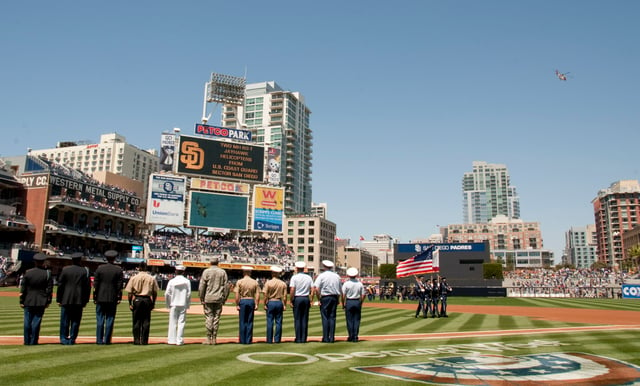
United States Coast Guard Jayhawk flying over Petco Park

Military service-members take to the field prior to the National Anthem being performed during Military Appreciation Day at Petco Park
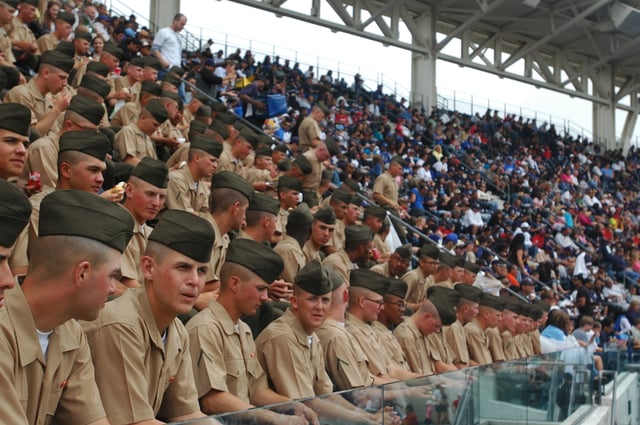
Recruits from Marine Corps Recruit Depot San Diego at Petco Park
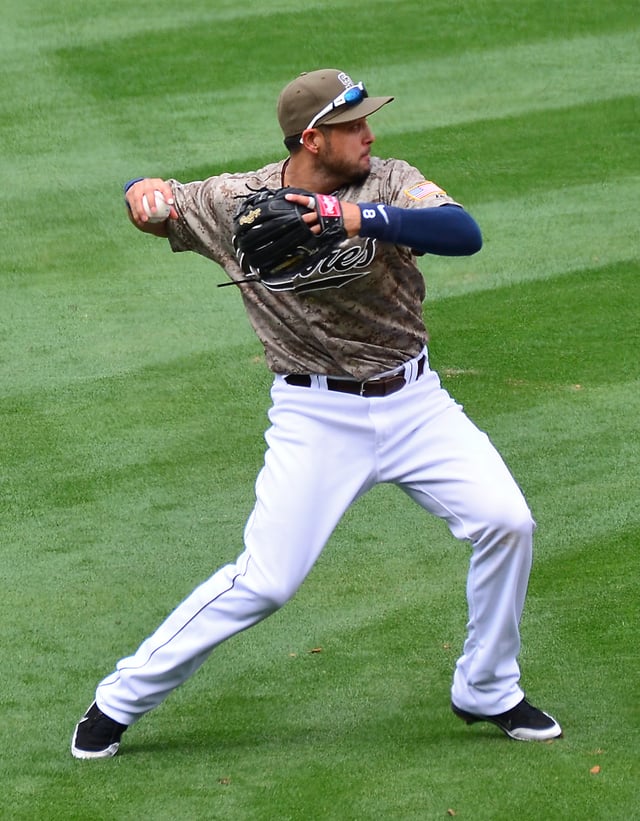
Jason Bartlett wearing the third iteration of the Padres camouflage uniform
Starting in 1996, the Padres became the first national sports team to have an annual military appreciation event.[11] Following in 2000, the Padres began wearing a camouflage to honor the military. The jersey has since gone through three different versions.[12][13][14] Starting in 2008, the Padres began wearing camouflage jerseys for every Sunday home game. They also wear these uniforms on Memorial Day, Independence Day, and Labor Day. Beginning in 2011, the Padres have changed the camouflage design to a more modern "digital" design, using the MARPAT design after receiving permission from then-Commandant Conway,[12] and dropped the green from the lettering and logo of the jersey. Green has been replaced by a sand-olive color (also in the cap worn with the jersey). Since 1995[15] Marine Recruits from the nearby Marine Corps Recruit Depot often visit the games en masse during Military Appreciation Day, in uniform, often filling entire sections in the upper deck of Petco Park. When they are present, the team commemorates this with a special Fourth Inning Stretch featuring the Marine Hymn.[16] Through April 2005 over 60,000 marine recruits were hosted by the Padres.[17] This is part of an extensive military outreach program, which also includes a series of Military Appreciation Night games,[18] and game tapes mailed to deployed United States Navy ships of the Pacific Fleet for onboard viewing (a large portion of the Pacific Fleet is homeported in San Diego).[19][20][21]
The San Diego area is home to a number of military installations, including several Navy and Coast Guard bases centered on San Diego Bay, Marine Corps Air Station Miramar (former home of the "Top Gun" training program), and the Marine Corps training ground at Camp Pendleton. Civilians employed at those bases account for around 5% of the county's working population.[22]
Mascot
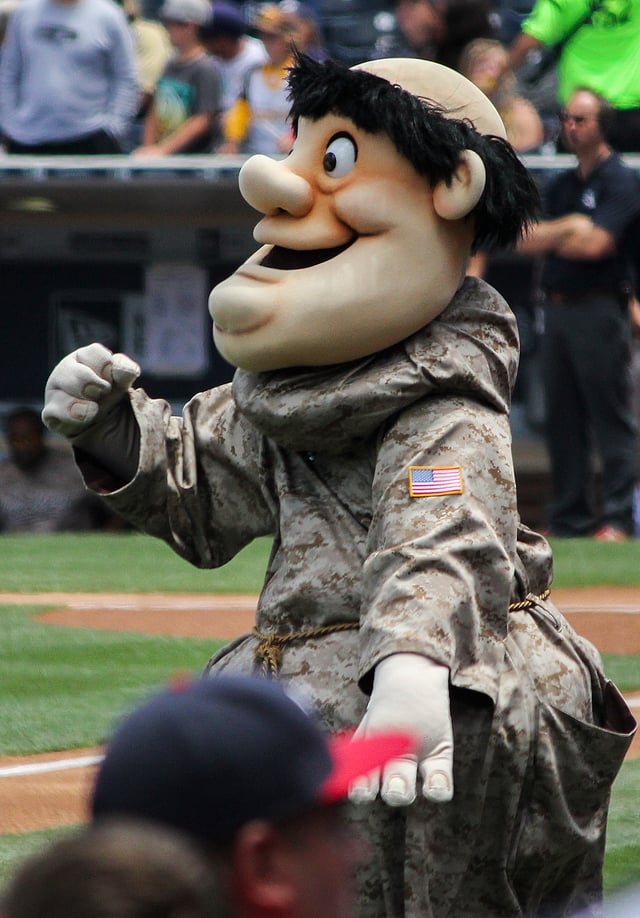
The "Swinging Friar".
The "Swinging Friar" is currently the mascot of the team. Some in the past have confused The Famous Chicken as the mascot of the Padres. Although he does make appearances occasionally at San Diego sporting events, he has never been the official mascot of any San Diego sports team.
Season records
Achievements
Award winners and league leaders
Team records (single-season and career)
Baseball Hall of Famers
The following elected members of the Baseball Hall of Fame played and/or managed for the Padres.
| San Diego Padres Hall of Famers | ||||||||||||||||||||||||||||||||||||
|---|---|---|---|---|---|---|---|---|---|---|---|---|---|---|---|---|---|---|---|---|---|---|---|---|---|---|---|---|---|---|---|---|---|---|---|---|
| Affiliation according to the National Baseball Hall of Fame and Museum | ||||||||||||||||||||||||||||||||||||
|
Ford C. Frick Award recipients (broadcasters)
| San Diego Padres Ford C. Frick Award recipients | |||||||||
|---|---|---|---|---|---|---|---|---|---|
| Affiliation according to the National Baseball Hall of Fame and Museum | |||||||||
|
Retired numbers

Numbers retired by the Padres displayed in Ring of Honor above the press box at Petco Park during the 2016 season
The Padres have retired six numbers. Five were in honor of Padre players and one was Jackie Robinson's number 42, which was retired by all of Major League Baseball.[23] The retired numbers are displayed on the upper deck facade behind home plate.
| No. | Retired number |
|---|---|
| Player | Name of player honored |
| Position | Player position |
| Career | Years played with Padres |
| Retired | Date number was retired |
| Member of Baseball Hall of Fame |
† Number retired by Major League Baseball
The Padres also have a "star on the wall" in honor of broadcaster Jerry Coleman, in reference to his trademark phrase "Oh Doctor! You can hang a star on that baby!" Nearby the initials of the late owner Ray Kroc are also displayed. Both the star and the initials are painted in gold on the front of the pressbox down the right field line accompanied by the name of the person in white. Kroc was honored in 1984, Coleman in 2001.
Team Hall of Fame
The following 14 people have been inducted into the San Diego Padres Hall of Fame since it was founded in 1999.[26]
| Year | Year inducted |
|---|---|
| Bold | Member of the Baseball Hall of Fame |
| Member of the Baseball Hall of Fame as a Padre | |
| Bold | Recipient of the Hall of Fame's Ford C. Frick Award |
| San Diego Padres Hall of Fame | ||||
| No. | Player | Position | Tenure | Inducted |
|---|---|---|---|---|
| — | Buzzie Bavasi | Team President | 1969–1977 | 2001 |
| 21 | Ken Caminiti | 3B | 1995–1998 | 2016 |
| 17 | Nate Colbert | 1B | 1969–1974 | 1999 |
| 2 | Jerry Coleman | Manager Announcer | 1980 1972-1979, 1981–2013 | 2001 |
| 19 | Tony Gwynn | RF | 1982–2001 | 2002 |
| 51 | Trevor Hoffman | P | 1993–2008 | 2014 |
| 35 | Randy Jones | P | 1973–1980 | 1999 |
| — | Ray Kroc | Owner | 1974–1984 | 1999 |
| 15 | Jack McKeon | GM/Manager | 1980–1990 | 2017 |
| 9, 09 | Benito Santiago | C | 1986–1992 | 2015 |
| — | Kevin Towers | GM | 1995–2009 | 2018 |
| 1 | Garry Templeton | SS | 1982–1991 | 2015 |
| 23 | Dick Williams | Manager | 1982–1985 | 2009 |
| 19 | Ted Williams | LF | 1936–1937 (PCL) | 2016 |
| 31 | Dave Winfield | RF | 1973–1980 | 2000 |
San Diego Hall of Champions
Gwynn, Winfield, Fingers, Gossage, Randy Jones, and Graig Nettles (3B, 1984–1987) are members of the San Diego Hall of Champions, which is open to athletes native to the San Diego area (such as Nettles) as well as to those who played for San Diego teams (such as Gwynn).
| Padres in the San Diego Hall of Champions | ||||
| No. | Player | Position | Tenure | Notes |
|---|---|---|---|---|
| — | Buzzie Bavasi | Team President | 1969–1977 | |
| 1 | Garry Templeton | SS | 1982–1991 | |
| 3 | Alan Trammell | Coach | 2000–2002 | Elected mainly on his performance with Detroit Tigers |
| 4 | Bob Skinner | Coach Manager | 1970–1973 1977 | Born in La Jolla |
| 7 | Tony Clark | 1B | 2008 | Elected mainly on his performance with Detroit Tigers |
| 8, 10 | Dave Roberts | OF Coach Manager | 2005–2006 2011–2015 | Raised in San Diego |
| 9 | Graig Nettles | 3B | 1984–1987 | Born and raised in San Diego, attended San Diego State |
| 19 | Ted Williams | LF | 1936–1937 (PCL) | Elected mainly on his performance with Boston Red Sox, born and raised in San Diego |
| 19 | Tony Gwynn | RF | 1982–2001 | Attended San Diego State |
| 31 | Dave Winfield | RF | 1973–1980 | |
| 33 | David Wells | P | 2004, 2006–2007 | Elected mainly on his performances with Toronto Blue Jays and New York Yankees, grew up in Ocean Beach, San Diego |
| 34 | Rollie Fingers | P | 1977–1980 | Elected mainly on his performance with Oakland A's |
| 35 | Randy Jones | P | 1973–1980 | |
| 51 | Trevor Hoffman | P | 1993–2008 | |
| 54 | Goose Gossage | P | 1984–1987 | |
Current roster
San Diego Padres roster | ||||||
|---|---|---|---|---|---|---|
| Active roster | Inactive roster | Coaches/Other | ||||
| Pitchers Starting rotation
| Catchers
| Pitchers Outfielders
| Manager
| |||
Championships
| National League Champions | ||
| Preceded by: Florida Marlins | 1998 | Succeeded by: Atlanta Braves |
| Preceded by: Philadelphia Phillies | 1984 | Succeeded by: St. Louis Cardinals |
| National League Western Division Champions | ||
| Preceded by: Los Angeles Dodgers | 2005 & 2006 | Succeeded by: Arizona Diamondbacks |
| Preceded by: San Francisco Giants | 1998 | Succeeded by: Arizona Diamondbacks |
| Preceded by: Los Angeles Dodgers | 1996 | Succeeded by: San Francisco Giants |
| Preceded by: Los Angeles Dodgers | 1984 | Succeeded by: Los Angeles Dodgers |
Minor league affiliations
| Level | Team | League | Location |
|---|---|---|---|
| AAA | El Paso Chihuahuas | Pacific Coast League | El Paso, Texas |
| AA | Amarillo Sod Poodles | Texas League | Amarillo, Texas |
| Advanced A | Lake Elsinore Storm | California League | Lake Elsinore, California |
| A | Fort Wayne TinCaps | Midwest League | Fort Wayne, Indiana |
| Short Season A | Tri-City Dust Devils | Northwest League | Pasco, WA |
| Rookie | AZL Padres | Arizona League | Peoria, Arizona |
| AZL Padres 2 | |||
| DSL Padres | Dominican Summer League | Dominican Republic |
Radio and television
Padres' games are currently televised by Fox Sports San Diego. Don Orsillo is the play-by-play announcer, with Mark Grant as color analyst and either Julie Alexandria, Ron Zinter, or Bob Scanlan as field reporter. Mike Pomeranz hosts the Padres Live pre- and post-game show along with Mark Sweeney.
As of the 2018 season, Padres radio broadcasts in English are carried by KWFN 97.3 The Fan, after having previously been carried by sister station 94.9 KBZT upon the acquisition of the radio rights by Entercom in 2017.[27][28] Ted Leitner is the primary play-by-play announcer, with Jesse Agler working the middle innings of each game and Bob Scanlan serving as color analyst. The games are also broadcast in Spanish on XEMO-AM,La Poderosa 860 AM, with Eduardo Ortega, Carlos Hernández and Pedro Gutiérrez announcing. Padre games were also aired from 2006–2010 on XHPRS-FM 105.7.
Spanish language telecasts of Sunday games are seen XHAS-TDT channel 33. Until September 2007, Friday and Saturday games were seen in Spanish on KBOP-CA channel 43, until that station changed to an all-infomercial format. This makes XHAS-TDT the only over-the-air-television station carrying Padres baseball. English-language Padres over-the-air broadcasts aired through the years on XETV-TV 6, KCST-TV 39, KUSI-TV 51, KFMB-TV 8 and KSWB-TV 69.
John Demott was the Padres' first public address announcer when the team began in 1969. By the late 1970s Bruce Binkowski had taken over as PA announcer, and became the longest-serving public address announcer in the team's history, remaining until the end of the 1999 season. First DeMott and then Binkowski also were responsible with PA announcing duties for the San Diego Chargers and the San Diego State University Aztecs, both of which were joint tenants at Qualcomm Stadium with the Padres until the Padres moved into Petco Park. From Petco Park's opening in 2004 until 2013, the PA announcer was Frank Anthony, a radio host with 105.7 XHPRS-FM. On April 19, 2014, Alex Miniak was announced as the new Public Address announcer for the San Diego Padres. Miniak was formerly the PA announcer for the New Hampshire Fisher Cats, the Double-A affiliate of the Toronto Blue Jays.[29]
The San Diego Padres were first portrayed in the 1979 NBC made-for-TV film "The Kid from Left Field," starring Gary Coleman as Jackie Robinson "J.R." Cooper, a youngster who is passionate about baseball, and puts his knowledge to good use when he becomes the manager of the Padres and helps them lead to the World Series.
In 2016, the San Diego Padres were portrayed once again in the one-season Fox television series Pitch, starring Kylie Bunbury as Ginny Baker, the first female to play in Major League Baseball.
Educational involvement
The San Diego Padres established The Padres Scholars program, the first of its kind among professional sports. Originally each Padres scholar was selected as a seventh grader and received a $5,000 scholarship after graduation from high school to go towards higher education. This program has reached 389 students from its establishment in 1995 to now. Over the past few years the program has undergone a few changes to be effective an education standpoint. This program focuses on creating a close relationship between the chosen scholars and the team. As of 2011, 3 high school seniors will be chosen to receive a $30,000 scholarship to be awarded through the course of their higher education. Maintaining this prestigious award is conditional on maintaining contact with the Padres and providing proof of good academic standing.[30]
The San Diego Padres are the sponsors of and heavily involved in most aspects of the Sports Business Management MBA degree program offered in conjunction with San Diego State University's College of Business Administration. SDSU's Sports MBA is the only program of its kind created in partnership with a professional sports franchise. The curriculum focuses on the entire sports business industry, not just baseball. The program includes an internship. Members of Padres senior management regularly participate, including work with the development and continued coordination of SDSU's International Case Competition, which annually attracts participation from top business schools.
See also
An American Journey: My Life on the Field, In the Air, and On the Air – Jerry Coleman's 2008 autobiography


